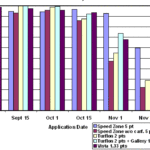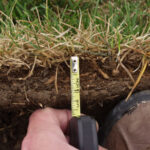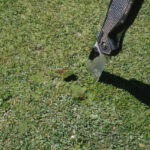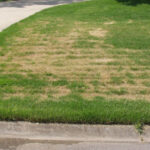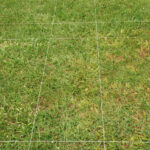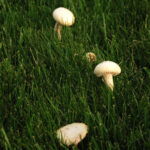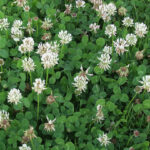Turf Tips Archives
Reminder: New golf course pesticide rule went into effect August 1, 2009
The Indiana State Chemists Office’s (ISCO) new pesticide rule went into effect Aug. 1 and includes: Any person applying any pesticide to a golf course must have a commercial pesticide applicator license or be under the direct supervision of a licensed commercial pesticide applicator. A non-certified applicator can apply pesticides if directly supervised by a […]
Goosegrass control is difficult in sports and golf turf
Goosegrass is a warm-season annual very similar to crabgrass, but germinates later than crabgrass and is tougher to control with both pre- and postemergence herbicides. It is most common in compacted, heavily used, poorly drained, and/or thinned turf, so cultural practices to help alleviate these conditions are essential. With low populations, cutting goosegrass out with […]
New web registration now available for the Midwest Regional Turf Field Day on July 21
We have just unveiled our new web registration for all MRTF functions, just time for Field Day on July 21. Registration for all events is at http://mrtf.org/php/education.php and registration for Field Day specifically is at http://mrtf.org/php/education.php#FieldDay. Some of the features of this year’s Field Day include A morning workshop in Spanish – Victoria Caceres will be teaching “White […]
For professionals only: Solitare herbicide now labeled for Indiana
FMC’s Solitare 75WG received its federal and state label for Indiana in June and is should be available from your professional product distributors. Solitare is a combination of sulfentrazone (Dismiss) and quinclorac (Drive and others) and should provide control of yellow nutsedge, crabgrass, clover and a wide variety of other broadleaf weeds that are currently […]
Controlling ground ivy and/or violets
As lawns start to thin from summer heat, ground ivy and violets begin to overtake the turf especially insahded areas. These two weeds remain tough to control in Indiana. Even though applications now can produce visible damage, long-term control does not compare to fall applications. We have been working on ground ivy for a number […]
The somewhat random world of herbicide burn injury on turf
With weather drying out and heating up, the risk of herbicide burn is increasing. In most cases, herbicide burn is similar to fertilizer burn in that the concentration of the herbicide spray residue on the leaf literally sucks the water out of the leaf, desiccating the leaf. This is similar to how urea fertilizer spilled […]
White Grub Biology and Control in Espanol
In response to requests from our industry, we will be teaching a workshop in Spanish at Field Day on July 21. “White Grub Biology and Control” will be taught by Victoria Caceres from the Department of Entomology. This is a great opportunity for you or any of your staff who are comfortable learning in Spanish […]
Patch Disease Symptoms Starting to Show in Dry Kentucky Bluegrass Lawns
Summer patch and necrotic ring spot are root-infecting diseases in Kentucky bluegrass lawns. Their symptoms are some of the most difficult to manage, much less control the disease. Although these diseases differ slightly in when they attack the roots, the pathogens generally are active in the late spring to early summer. Infection-impaired roots have a […]
Using clover for lawns?????
Recently I was contacted by a major newspaper reporter who was writing an article about more sustainable lawn systems, or lawns that would required fewer inputs, and was inquiring about the feasibility of using clover as a lawn turf. After a brief head-scratching and a few questions about his intent we had a nice conversation […]
Summer Mowing and Fertilization
By the time you read these words the longest day of the year has approached and the official calendar “Summer” season will have begun. Just as the weather changes as we transition between seasons from late-Spring to Summer the turfgrass plant changes too. First, both air and soil temperatures rise beyond what is optimal for […]
Moss in greens
I’ve gotten a number of questions about moss lately. Moss is becoming more common in greens as we decrease mowing heights and nitrogen fertility in pursuit of faster green speeds. Moss becomes more competitive as creeping bentgrass becomes less competitive. Though the herbicide QuickSilver has become the industry standard when applied at 6.7 oz/A, a […]
Reicher to join University of Nebraska in March
After 21 years at Purdue, 17 of which as the Extension Specialist, I will be leaving Purdue University. Kim and I will be moving to the University of Nebraska-Lincoln where Kim will become the Director of Landscape Architecture and Regional Planning in the School of Architecture in mid-August. I am what’s considered a “spousal hire” […]
Poa annua, Poa trivialis, and/or creeping bentgrass in lawns and sports fields
Poa annua (annual bluegrass), Poa trivialis (rough bluegrass) and creeping bentgrass are becoming common weeds in athletic fields and lawns. These weeds are important to distinguish because they require different controls. Poa annua: a winter annual that is lighter, more apple green than other lawn species. It is just past its aggressive seedhead stage, but you’ll likely still find […]
New topics and tours at the Turf Field Day on July 21
The Midwest Regional Turf Field Day that will be held on Tuesday, July 21 at the W.H. Daniel Turfgrass Research and Diagnostic Center in West Lafayette. A number of additions should make this one of the best field days yet. The field day includes: A morning workshop in Spanish – Victoria Caceres will be teaching “White […]
Believe it or not, drought symptoms appearing in turf
With no rain in Indiana last week (5/17-23) followed by extremely erratic and spotty rain this week (5/24-30), drought symptoms are starting to show up near sidewalks and driveways and in other hotspots like south-facing slopes, compacted soils, and fairly new sod laid over compacted soils. Symptoms are typical drought stress starting out with a […]
Rhizoctonia Spring Patches
Brown Ring Patch Brown ring patch is a disease of annual bluegrass on putting greens. Damage is largely cosmetic, although in some areas smoothness and uniformity of putting surfaces are disturbed, warranting chemical control. The duration of symptom expression usually is brief (one or two weeks), and coincides with mild weather with ample moisture. Despite […]
Southern IN: Controlling common lespedeza (Lespedeza striata)
A common concern in southern Indiana lawns is common lespedeza, which is a summer annual spreading by wiry stems from a single taproot forming almost a mat in thin turf or next to sidewalk. The most common broadleaf herbicide is 2,4-D, but this is completely ineffective against lespedeza. A recent report from John Boyd at […]
Dallisgrass healthy in southern IN
Dallisgrass has reemerged and is very healthy with the rain and warming temperatures. Dallisgrass is often mistaken for crabgrass but typical preemergence or post emergence crabgrass herbicides do not work on dallisgrass. MSMA is currently the standard control but that herbicide will not be available after 2010. Our current research is focusing on Syngenta’s Tenacity […]
Effects of wet spring on turf
With the well-above average rainfall this spring, questions are starting to arise about the short and long term effects on lawn, golf, and sports turf: Rooting-Though no official records are kept, rooting tends to be shallow and limited on water-logged soils because of a lack of oxygen. Effects of a wet spring like this spring […]
White Clover in Golf Courses, Sports Turf, and Lawns
The small white flowers of white clover are very visible right now and it may appear that clover is taking over, especially under-fertilized turf areas. Clover is a legume and is very competitive under low N conditions, so increasing annual N is best method to help exclude this weed. However, its spreading stolons make it […]
